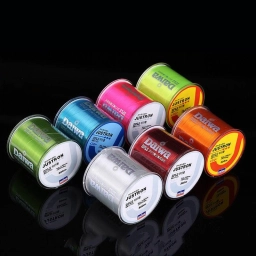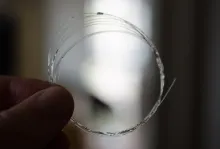Monofilament nylon, or mono as it is referred, is by far the most popular leader material in use today.
Types of Leader Material
Clear Monofilament Nylon
Monofilament nylon, or "mono" as it is referred, is by far the most popular leader material in use today. Extruded nylon and co-polymer nylons comprise the best leader materials today. Stiffer mono, such as Maxima or Amnesia line offer great material as butt and taper sections. Co-polymer, being softer materials, such as Orvis SuperStrong, Umpqua, Dai Riki Velvet and Rio PowerFlex, make for great taper and tippet materials.
Colored Monofilament Nylon
A lot of mono lines aren't clear, but colored due to various reasons, normally because they are simply dyed. The best known unclear mono is probably Maxima, which is preferred for leaders by many anglers, not least because it's quite stiff. Oftentimes the butt section of a sturdy leader works better when the line is not too supple, and the Maxima excels there.
The Maxima is a brownish hue, the thicker lines quite dense in the color, almost black.
Other better known colored lines are lines from the manufacturer Stren, known for its Yellow Stren, as well as the brightly red Amnesia line from Sunset. Many brands, like Daiwa whose lines are seen in the picture, can deliver monofilament in many colors. For some leader applications a bright color can be desirable, like when fishing with a light nymph, where a greased leader butt section in a bright color can help detect strikes.
Apart from that most anglers prefer clear or at least lightly colored lines in natural earth colors.
Fluorocarbon
Fluorocarbon filament leader material was introduced around 1993 by several leading manufacturers. Fluorocarbon material has several distinct advantages over standard monofilament materials. It's much more dense than water, thus it will sink faster than standard monofilament leader material. Fluorocarbon material also has the advantage of being more abrasion-resistant; which makes it a better choice for streamer leaders, nymph leaders and saltwater tippets. Another appealing trait is it's near-transparent nature - more so than standard mono.
Fluorocarbon also has a few minor drawbacks, however. It isn't nearly as strong as standard mono and you must be sure of your knots when using fluorocarbon material. Fluorocarbon material tends to require more secure knots for sure-hold tippet section. Try using a surgeon's knot with three loops versus the standard two. I've found much greater success in retaining knot strength using a triple-loop surgeon's knot when affixing fluorocarbon tippet material to a leader section.
What the Manufacturers Don't Tell You Stiffness Rating
Manufacturers will tell you the diameter and pound test and maybe even the color, but they don't tell you a stiffness rating. Mason mono is hard, we all know, and Orvis SuperStrong is soft, but you couldn't tell by the names or the packages.
A simple method to determine if the stiffness of the leader material matches the stiffness of your fly line is to bend a section of each in half with your fingers and "feel" the approximate stiffness of each. You'll easily be able to feel the difference in the resistance to the bend. If you use a butt material that is too flimsy, you'll experience the "hinge" effect when you cast. The leader will not turn over properly and hinge where the fly line and leader connection is made. Get over this hurdle and you're well on your way to a designing proper leader.
Leader Pound/Test Formula
While each manufacturer of leader material boasts a different pound test rating, they all generally are within a predictable range. For example, most 8x tippets are around 1.2 lbs test. Likewise, most 0X tippets approximate 12 lbs test. I've developed a formula to approximate the pound test of the average Monofilament leader material. The formula is based upon the tippet diameter having a direct relation to the pound test a tippet can withstand. Specifically, the formula is
((diameter x 1000)2 / 11) + (diameter x 100)
Knowing that this formula is cumbersome to remember, a quick method formula can replicate similar estimation results. The Quick Formula is:
((diameter x 1000)2 / 10)
The formula is compared to a dataset of 15 different leader monofilaments showing the high test rating, the low test rating and the average test rating. As you can see by the wide variety of diameter-to-pound/test ratings, there is no industry standard...or even industry average. The formulas I've developed try to 'even out' the playing field and fairly estimate with some degree of reasonableness, pound tests for a given diameter of leader material. The tables below show calculations for 8X through 08X tippets.
| Monofilament Pound Test Estimations - 08X through 01X | ||||||||
| Tippet Designation | 08X | strong>07X | 06X | 05X | 04X | 03X | 02X | 01X |
| Tippet Diameter | 0.019" 0.55mm |
0.018" 0.50mm |
0.017" 0.45mm |
0.016" 0.40mm |
0.015" 0.38mm |
0.014" 0.35mm |
0.013" 0.33mm |
0.012" 0.30mm |
| Schweitzer lb Test Formula | 34.7 | 31.3 | 28.0 | 24.9 | 22.0 | 19.2 | 16.7 | 14.3 |
| Schweitzer Quick Method | 36.1 | 32.4 | 28.9 | 25.6 | 22.5 | 19.6 | 16.9 | 14.4 |
| High Value in Dataset | 45.0 | 26.4 | 35.0 | 25.0 | 28.0 | 17.6 | 21.0 | 18.5 |
| Low Value in Dataset | 17.6 | 12.0 | 13.2 | 25.0 | 10.0 | 17.6 | 7.0 | 6.0 |
| Average of Dataset | 29.5 | 21.5 | 23.3 | 25.0 | 17.9 | 17.6 | 13.7 | 9.8 |
| Monofilament Pound Test Estimations - 0X through 8X | |||||||||
| Tippet Designation | 0X | 1X | 2X | 3X | 4X | 5X | 6X | 7X | 8X |
| Tippet Diameter | 0.011" 0.28mm |
0.010" 0.25mm |
0.009" 0.23mm |
0.008" 0.20mm |
0.007" 0.18mm |
0.006" 0.15mm |
0.005" 0.13mm |
0.004" 0.10mm |
0.003" 0.08mm |
| Schweitzer lb Test Formula | 12.1 | 10.1 | 8.3 | 6.6 | 5.2 | 3.9 | 2.8 | 1.9 | 1.1 |
| Schweitzer Quick Method | 12.1 | 10.0 | 8.1 | 6.4 | 4.9 | 3.6 | 2.5 | 1.6 | 0.9 |
| High Value in Dataset | 15.5 | 13.5 | 11.5 | 8.5 | 6.4 | 5.2 | 3.8 | 2.5 | 1.8 |
| Low Value in Dataset | 4.4 | 4.0 | 6.6 | 5.7 | 4.8 | 4.0 | 2.8 | 1.9 | 1.0 |
| Average of Dataset | 9.8 | 8.5 | 8.3 | 6.9 | 5.4 | 4.3 | 3.2 | 2.2 | 1.4 |
- Log in to post comments









About Leader Material
I am a fan of Maxima and have used it to make leaders for many years but would like to add a word of caution. I use a micrometer to check diameter of every spool of material I buy and over many years, Maxima's diameters has been very inconsistent (diameter understated between .002 and .003 in heavier lb. test). Might not sound like a lot but unless you check, you're leader will be far heavier than you thought.
Great article! Thank you!
Great article! Thank you!
When developing leaders for my custom leader company, I’ve found that Maxima Chameleon offers the stiffest nylon. This I generally use for the first two butt sections. We switch to Maxima clear for the middle taper sections. For the final taper and tipett, we’ll use a supple material.
The above allows for great casting and line layout, depending upon the application. The diameter of the the line used can be changed as needed, also depending upon the user’s requirements for casting delicacy.